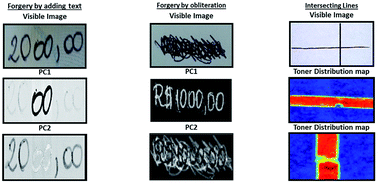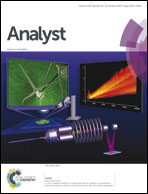Near infrared hyperspectral imaging for forensic analysis of document forgery
Abstract
Hyperspectral images in the near infrared range (HSI-NIR) were evaluated as a nondestructive method to detect fraud in documents. Three different types of typical forgeries were simulated by (a) obliterating text, (b) adding text and (c) approaching the crossing lines problem. The simulated samples were imaged in the range of 928–2524 nm with spectral and spatial resolutions of 6.3 nm and 10 μm, respectively. After data pre-processing, different chemometric techniques were evaluated for each type of forgery. Principal component analysis (PCA) was performed to elucidate the first two types of adulteration, (a) and (b). Moreover, Multivariate Curve Resolution–Alternating Least Squares (MCR-ALS) was used in an attempt to improve the results of the type (a) obliteration and type (b) adding text problems. Finally, MCR-ALS and Partial Least Squares–Discriminant Analysis (PLS-DA), employed as a variable selection tool, were used to study the type (c) forgeries, i.e. crossing lines problem. Type (a) forgeries (obliterating text) were successfully identified in 43% of the samples using both the chemometric methods (PCA and MCR-ALS). Type (b) forgeries (adding text) were successfully identified in 82% of the samples using both the methods (PCA and MCR-ALS). Finally, type (c) forgeries (crossing lines) were successfully identified in 85% of the samples. The results demonstrate the potential of HSI-NIR associated with chemometric tools to support document forgery identification.

- This article is part of the themed collection: Analytical Sciences in Brazil

 Please wait while we load your content...
Please wait while we load your content...